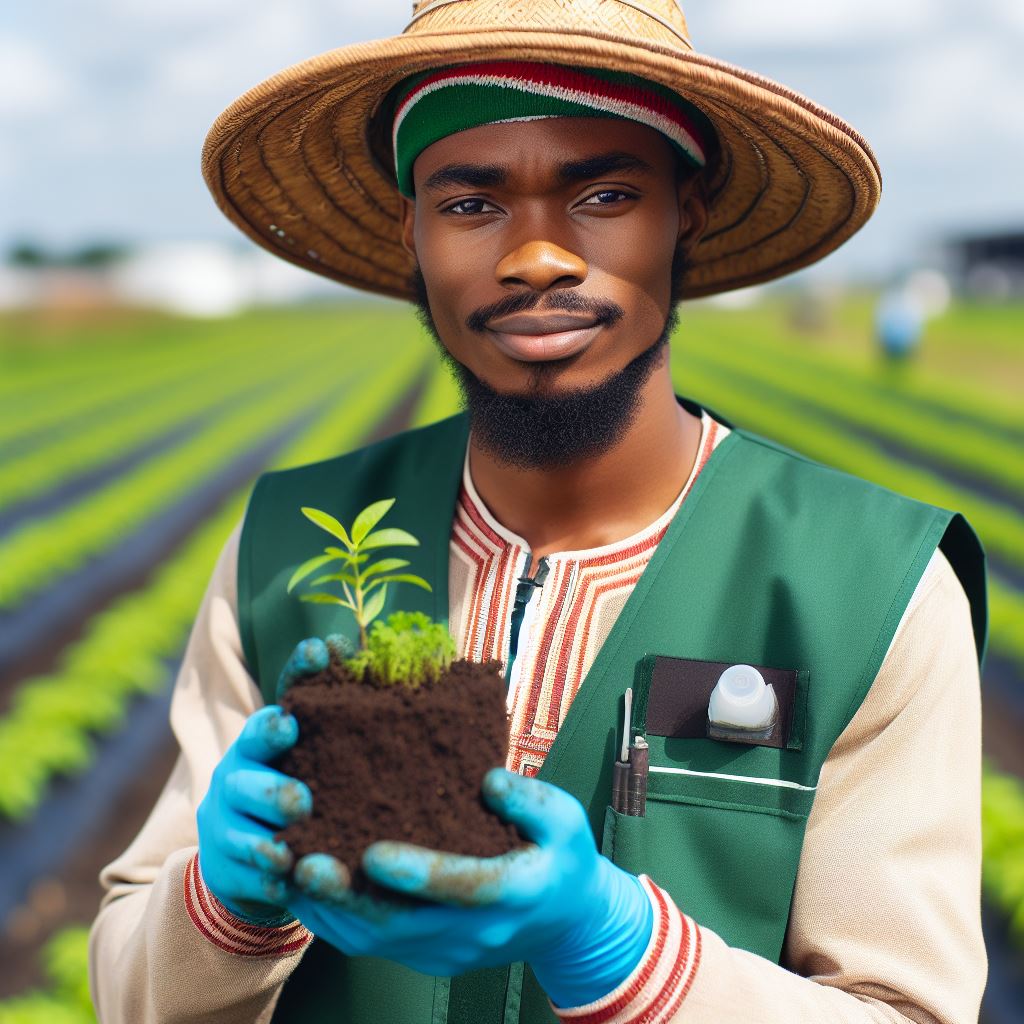Introduction
Significance of Technology in Crop Science Education in Nigeria
Technology revolutionizes crop science education in Nigeria by enhancing learning efficiency.
It equips students with practical skills crucial for modern agricultural practices.
Adopting tech-driven teaching methods facilitates understanding complex concepts in crop science.
This integration fosters innovation, empowering future agricultural leaders in Nigeria.
Purpose of the Blog Post
This blog aims to explore how integrating technology enriches crop science education in Nigeria.
It highlights the transformative impact of technology on learning outcomes, fostering a deeper understanding of agricultural principles.
By showcasing innovative tech applications, this post seeks to inspire educators and policymakers to embrace these advancements in the curriculum.
Current state of crop science education in Nigeria
Traditional methods used in crop science education
In Nigeria, crop science education has predominantly relied on traditional methods such as lectures and textbooks.
Teachers often use chalkboards and whiteboards to convey information to students.
Practical sessions are conducted in small plots of land or demonstration farms, where students learn through observation and hands-on experience.
Students also rely on field trips to agricultural research stations and farmers’ fields to further enhance their understanding.
Traditional methods encourage passive learning, where students are expected to absorb information without active participation.
Assessments primarily consist of written examinations, which test theoretical knowledge rather than practical skills.
These traditional methods have been used for decades, but they have several limitations and challenges.
Limitations and challenges faced in current crop science education practices
Traditional methods often fail to engage students fully, as they are passive recipients of information.
There is a lack of practical application of theoretical concepts, limiting students’ ability to apply knowledge to real-life scenarios.
Access to teaching resources, such as textbooks and research papers, may be limited in some educational institutions.
Infrastructure challenges, including inadequate classroom space and outdated teaching equipment, hinder effective teaching and learning.
Funding limitations restrict the implementation of innovative approaches and the acquisition of modern teaching technologies.
Teacher-centered approaches reduce student engagement and hinder critical thinking and problem-solving skills development.
Limited exposure to emerging technologies and practices prevents students from being at the forefront of agricultural advancements.
The need for technological integration
Incorporating technology into crop science education is necessary to overcome the limitations and challenges.
Technological integration promotes active learning, stimulating students’ curiosity and enhancing their understanding.
Interactive multimedia tools, such as videos and animations, can be used to explain complex concepts more effectively.
Simulations and virtual labs allow students to conduct experiments in a controlled environment, enhancing practical skills.
Online platforms and databases provide access to a wide range of resources, fostering research and independent learning.
Modern teaching technologies, such as projectors and computers, can improve the quality of classroom instruction.
E-learning platforms and mobile applications enable students to learn at their own pace and access educational materials anytime, anywhere.
Technological integration also exposes students to precision agriculture techniques and emerging agricultural trends.
Developing digital literacy skills equips students with valuable knowledge for future careers in the agricultural sector.
In essence, the current state of crop science education in Nigeria heavily relies on traditional methods, which have limitations and challenges.
To overcome these challenges, there is a pressing need to incorporate technology into crop science education.
Technological integration promotes active learning, enhances practical skills, and provides access to a wealth of resources.
By embracing technology, Nigeria can ensure that its crop science education remains relevant and prepares students for the advancements in the agricultural industry.
Read: Future Careers: Studying Environmental Management in Nigeria
Benefits of incorporating technology in crop science education
How technology can enhance learning experiences in crop science
Incorporating technology into crop science education offers numerous benefits to both students and the agricultural sector.
By leveraging the power of technology, learners can access a wealth of information and resources, enhancing their understanding of crop science concepts.
Interactive and multimedia materials further enrich the learning experience by presenting complex ideas in engaging ways.
How technology can increase student engagement and participation
Moreover, technology promotes student engagement and active participation.
By creating a dynamic learning environment, technology encourages students to take ownership of their learning and explore topics at their own pace.
Transform Your Career with Expert Guidance
Get personalized mentorship consulting that’s tailored to your unique path. Our expert advice is actionable and exclusive.
Get StartedCollaborative tools enable students to work together, fostering teamwork and knowledge sharing among peers.
Potential for improved crop yield and agricultural practices with the help of technology
Furthermore, the integration of technology holds great potential for improved crop yield and agricultural practices.
Remote sensing technologies and precision agriculture tools provide farmers with valuable insights into crop health, soil conditions, and pest infestations.
This information allows for precise resource allocation, reducing waste and environmental impact while maximizing productivity.
Data analytics and machine learning algorithms help farmers identify patterns, enabling them to fine-tune farming techniques for greater efficiency and profitability.
Real-time monitoring through Internet of Things (IoT) devices equips farmers with up-to-date information on environmental factors, enabling them to make timely decisions and optimize their crop management strategies.
In addition, farm management software streamlines administrative tasks, simplifies planning, and enhances record-keeping.
This technology empowers farmers to better manage their operations while improving traceability and compliance with agricultural regulations.
In fact, incorporating technology into crop science education offers a multitude of benefits.
It enhances learning experiences, increases student engagement, and unlocks the potential for improved crop yield and agricultural practices.
By embracing technology, Nigeria can equip its future agricultural workforce with the necessary skills and knowledge to drive innovation and sustainability in the agricultural sector.
Read: Fieldwork and Internships: Gaining Practical Experience in Nigeria
Examples of technology in crop science education
Use of agricultural mobile applications for learning purposes
Agricultural mobile apps provide students with valuable resources and interactive learning tools for crop science education.
These apps offer features such as digital field guides, pest and disease identification, and crop management recommendations.
Students can access real-time data and information, allowing them to stay updated with the latest advancements in crop science.
By using these mobile apps, students can enhance their understanding of crop cultivation techniques and improve their decision-making skills.
Importance of utilizing virtual reality and augmented reality in crop science education
Virtual reality (VR) and augmented reality (AR) can revolutionize the way students learn about crop science.
Through VR, students can immerse themselves in virtual environments, replicating real-life farm scenarios.
This technology allows students to practice hands-on skills, such as planting, harvesting, and crop disease diagnosis, in a safe and controlled setting.
AR enhances the learning experience by overlaying digital information on real-world crop fields, making it easier for students to identify different plant species or recognize signs of nutrient deficiencies.
These technologies engage students and make learning more interactive and engaging, leading to better retention and understanding of crop science concepts.
Role of drones and precision agriculture in enhancing hands-on learning experiences
Drones have become valuable tools for crop science education, enabling students to collect aerial data and monitor crop health more efficiently.
With drones, students can analyze crop fields, identify problem areas, and make data-driven recommendations for improving crop yields.
Precision agriculture techniques, combined with drone technology, allow students to gather precise information about soil moisture, temperature, and nutrient levels.
By utilizing this information, students can optimize crop management practices and make informed decisions regarding fertilizer application and irrigation scheduling.
Additionally, drones provide students with a practical understanding of remote sensing and its applications in crop science research.
In short, incorporating technology into crop science education in Nigeria offers numerous benefits.
Agricultural mobile apps, virtual reality, augmented reality, and drones provide students with innovative ways to learn and engage with crop science concepts.
By embracing these technological advancements, educators can foster a passion for agriculture among students and prepare them for future careers in the field.
Read: Case Study: Nigeria’s Cross River National Park Success

Strategies for incorporating technology in crop science education in Nigeria
Importance of training teachers on technology integration
- Teachers need to be equipped with the necessary skills and knowledge to effectively integrate technology in crop science education.
- Training teachers on technology integration ensures they can confidently use and implement various tech tools and resources.
- Proper training empowers teachers to create engaging and interactive lessons that enhance students’ understanding of crop science.
- Teachers who receive technology integration training can effectively guide students in using technology for research and experimentation.
- Continuous training enables teachers to stay updated with the latest technological advancements in the field of crop science.
The need for providing access to technology and internet connectivity in schools
- Ensuring schools have access to technology and internet connectivity allows students to explore a wide range of online resources.
- Access to technology enables students to conduct virtual experiments, simulations, and data analysis in crop science.
- Internet connectivity in schools facilitates collaboration among students and provides opportunities for knowledge sharing.
- Providing access to technology bridges the digital divide and promotes equality in education.
- Access to technology and the internet prepares students for future careers in the agriculture and crop science sector, where technology is indispensable.
Importance of creating partnerships with tech companies and agricultural institutions
- Partnerships with tech companies allow schools to access the latest tools and resources for crop science education.
- Tech companies can provide training and support to teachers, ensuring effective integration of their products in the classroom.
- Agricultural institutions can offer expertise and guidance in using technology to enhance crop science education.
- Partnerships with agricultural institutions enable students to engage in real-world projects and gain practical knowledge.
- Collaboration with tech companies and agricultural institutions fosters innovation and keeps crop science education relevant and up-to-date.
Overall, incorporating technology in crop science education in Nigeria is essential for equipping students with relevant skills and knowledge.
By training teachers, providing access to technology, and fostering partnerships, Nigerian schools can embrace the benefits of technology and prepare students for a sustainable future in the agricultural sector.
Read: Innovations and Breakthroughs: Nigerian Crop Science Research
Challenges and possible solutions
Potential challenges of integrating technology in crop science education
Integrating technology into crop science education in Nigeria may face several challenges.
One of the main challenges is the cost and accessibility of technology devices for both students and educators.
Many schools, especially in rural areas, may not have the necessary resources to provide students and teachers with computers or other digital gadgets.
Additionally, the lack of proper infrastructure and internet connectivity in remote areas can hinder the effective implementation of technology-based teaching methods.
Another challenge is the inadequate training and technical skills among teachers.
Many educators may not be well-versed in using technology for educational purposes.
Therefore, they may struggle to incorporate technology into their crop science lessons effectively.
Resistance to change and traditional teaching methods can also be a significant hurdle.
Some teachers may be reluctant to let go of traditional teaching methods and may not see the value of integrating technology into their classrooms.
Moreover, potential distractions and misuse of technology in the classroom need to be addressed.
Students may be tempted to use technology for non-educational purposes, leading to decreased productivity and focus.
It is crucial to establish guidelines and policies to promote responsible use of technology in the classroom.
Potential solutions to overcome these challenges, such as government support and funding
To overcome these challenges, government support and funding are essential.
The government should prioritize and allocate sufficient funds for technology integration in education.
This includes providing schools with necessary infrastructure, such as computers and internet connectivity.
Furthermore, establishing technology centers in rural areas and remote communities can help bridge the accessibility gap in these regions.
In addition, providing training programs and workshops to enhance teachers’ technical skills is crucial.
Educators need to be equipped with the necessary knowledge and skills to effectively integrate technology into their crop science lessons.
Collaboration and sharing of best practices among educators can also be beneficial in overcoming challenges.
Teachers can learn from one another and exchange ideas on how to overcome barriers to technology integration.
Importance of continuous research and development in the field of technology integration in education
Continuous research and development in the field of technology integration in education are of utmost importance.
Ongoing research helps identify innovative and effective ways to incorporate technology into crop science education.
Regular evaluation of existing technology resources and practices ensures their quality and efficiency.
This evaluation process enables improvements and modifications based on feedback from teachers and students.
Furthermore, research and development drive the creation of new educational technologies tailored to specific needs.
As technology advances, new tools and applications can be developed to enhance crop science education in Nigeria.
Continuous learning and adaptation to emerging technologies are necessary to ensure the relevance and effectiveness of teaching methods.
Collaboration between researchers, educators, and technology developers is vital in advancing technology integration in education.
Sharing knowledge and experiences fosters improvement and growth in the field.
By working together, stakeholders can create a conducive environment for effective technology integration in crop science education.
In a nutshell, integrating technology into crop science education in Nigeria comes with challenges such as cost and accessibility, inadequate training, resistance to change, and potential distractions.
However, through government support and funding, training programs, research, and collaboration, these challenges can be overcome.
Continuous research and development in technology integration are crucial for staying up-to-date with emerging technologies and ensuring the effectiveness of teaching methods.
Conclusion
Summarizing Key Points
In Nigeria, merging technology with crop science education revolutionizes learning.
Digital tools enhance understanding, making concepts more accessible.
Mobile apps offer real-time data, aiding practical learning experiences.
Virtual simulations simulate crop growth, fostering hands-on learning.
E-learning platforms facilitate broader access to quality agricultural education.
Technology integration diversifies teaching methods, catering to varied learning styles.
Reinforcing Importance
Incorporating technology vitalizes crop science education in Nigeria.
It bridges gaps, improving comprehension and retention among students.
This approach nurtures innovation, fostering a tech-savvy agricultural workforce.
Enhanced skills empower farmers, boosting agricultural productivity and sustainability.
It aligns education with industry demands, ensuring relevance and competitiveness.
Call to Action
To delve deeper, explore online courses, workshops, or webinars.
Engage in forums discussing the fusion of technology and agriculture.
Support initiatives advocating for tech-integrated agricultural curriculums.
Embrace technology; it’s the cornerstone for Nigeria’s agricultural advancement.
Stay updated on emerging technologies reshaping the agricultural landscape.
The integration of technology into crop science education in Nigeria holds immense promise.
It not only enriches learning experiences but also propels the nation towards agricultural excellence.
Embracing this symbiosis between technology and education is pivotal for sustainable farming practices, empowered farmers, and a thriving agricultural sector.
Let’s embark on this transformative journey together!




